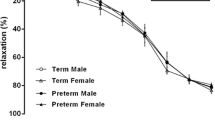Abstract
Objective
To define the vascular actions of selected sex steroids on human umbilical artery and vein and to determine whether there are any gender-specific differences in vasorelaxation between umbilical cord vessels of male and female fetuses.
Methods
Segments of umbilical artery (n = 12) and umbilical vein (n = 8) from male and female fetuses were suspended in organ baths of Krebs solution for isometric tension recording. The vessels were contracted using 60 mM potassium chloride followed by exposure to increasing concentrations (10-7 to 10-4 M) of sex steroid hormones (estradiol-17β, estriol, estrone, testosterone, and progesterone). A specific estrogen receptor antagonist (ICI 164,384) was used to attempt to block the estradiol effect. Changes in tension were recorded.
Results
Of the agents tested, estradiol- 17β had the greatest effect (25—29% relaxation at 10-4 M concentration), which was uninhibited by a specific receptor antagonist. The other steroids tested had no significant effect, even at 10-4 M concentration. The umbilical artery is slightly more sensitive to the effects of estradiol than the umbilical vein. There were no gender-specific differences noted in either artery or vein harvested from male or female fetuses.
Conclusion
Estradiol-11β in supraphysiologic concentrations has a non-receptor—mediated vasorelaxation effect on human umbilical blood vessels. (J Soc Gynecol Invest 1999;6:27–31)
Similar content being viewed by others
References
Buster J, Carson S. Placental endocrinology and diagnosis of pregnancy. In: Gabbe S, Niebyl J, Simpson J, eds. Obstetrics: normal and problem pregnancies. New York: Churchill Livingstone, 1991.
Werner C, Martinez E, Zhu LK, Ghodsi A, Chestnut D. In vitro release of endothelium-derived relaxing factor by acetylcholine is increased during the guinea pig pregnancy. Am J Obstet Gynecol 1989;161:1599–605.
Jiang CW, Sarrel PM, Lindsay DC, Poole-Wilson PA, Collins P. Endothelium-independent relaxation of rabbit coronary artery by 17 beta-oestradiol in vitro. Br J Pharmacol 1991;104:1033–7.
Mugge A, Riedel M, Barton M, Kuhn M, Lichtlen PR. Endothelium independent relaxation of human coronary arteries by 17 beta-oestradiol in vitro. Cardiovasc Res 1993;27:1939–42.
Weiner CP, Lizasoain I, Baylis SA, Knowles RG, Charles IG, Moncada S. Induction of calcium-dependent nitric oxide synthases by sex hormones. Proc Natl Acad Sci USA 1994;91: 5212–6.
Miller VM. Vanhoutte PM. Progesterone and modulation of endothelium-dependent responses in canine coronary arteries. Am J Physiol 1991;261:R1022–7.
Belfort M, Saade G, Kramer W, Suresh M, Moise K, Vedernikov Y. The vasodilator effect of 17 beta-estradiol on isolated human omental artery is predominantly mediated by prostacyclin, and not nitric oxide. Am J Obstet Gynecol 1995;172:319.
Belfort MA, Saade GR, Wen TS, Vedernikov YP. The direct action of 17 beta-estradiol in isolated omental artery from nonpregnant and pregnant women is related to calcium antagonism. Am J Obstet Gynecol 1996;175:1163–72.
Belfort MA, Saade GR, Suresh M, Vedernikov YP. Effects of estradiol-17 beta and progesterone on isolated human omental artery horn premenopausal nonpregnant women and from nor-motensive and preeclamptic pregnant women. Am J Obstet Gynecol 1996;174:246–53.
Sybulski S, Maughan GB. The effect of isoxsuprine treatment of estrogen levels in maternal and umbilical cord plasma. J Reprod Med 1975;15:232–6.
Silva de Sa M. Vasodilating effect of estrogen on the human umbilical artery. Gynecol Invest 1977;8:307–13.
Makila UM, Jouppila P, Kirkinen P, Viinikka L, Ylikorkala O. Relation between umbilical prostacyclin production and blood-flow in the fetus. Lancet 1983;1:728–9.
Gude NM, Rice GE, King RG, Boura AL, Brennecke SP. Analysis of the responses of the fetal vessels of human perfused placental lobules to acute infusions of arachidonic acid. Reprod Fertil Dev 1990;2:591–6.
Sonilyo A, Woo C, Somlyo A. Responses of nerve free vessels to vasoactive amines and polypeptides. Am J Physiol 1965;208:74–83.
McGrath JC, MacLennan SJ, Whittle MJ. Comparison of the effects of oxygen, 5-hydroxytryptamine, bradykinin and adrenaline in isolated human umbilical artery smooth muscle. Q J Exp Physiol 1988;73:547–59.
Fox SB, Khong TY. Lack of innervation of human umbilical cord: An immunohistologieal and histochemical study. Placenta 1990;11:59–62.
Colburn P, Buonassisi V. Estrogen-binding sites in endothelial cell cultures. Science 1978;201:817–9.
Horwitz KB, Horwitz LD. Canine vascular tissues are targets for androgens, estrogens, progestins, and glucocorticoids. J Clin Invest 1982;69:750–8.
Belfort M, Van den Veyver I, Vedernikov Y, Ferry R, Saade G, Komm B. Estrogen and progesterone receptor gene expression in umbilical artery and vein during human pregnancy. J Soc Gynecol Invest 1996;3(Suppl 2):262A.
Stallone JN. Sex differences in nitric oxide-mediated attenuation of vascular reactivity to vasopressin are abolished by gonadectomy. Eur J Pharmacol 1994;259:273–83.
Author information
Authors and Affiliations
Corresponding author
Additional information
This work was supported by a Grant-In-Aid from the American Heart Association and by a grant from The Women’s Fund of Texas.
Rights and permissions
About this article
Cite this article
Fausett, M.B., Belfort, M.A., Nanda, R. et al. The Effects of Sex Steroids on Human Umbilical Artery and Vein. Reprod. Sci. 6, 27–31 (1999). https://doi.org/10.1177/107155769900600107
Published:
Issue Date:
DOI: https://doi.org/10.1177/107155769900600107




